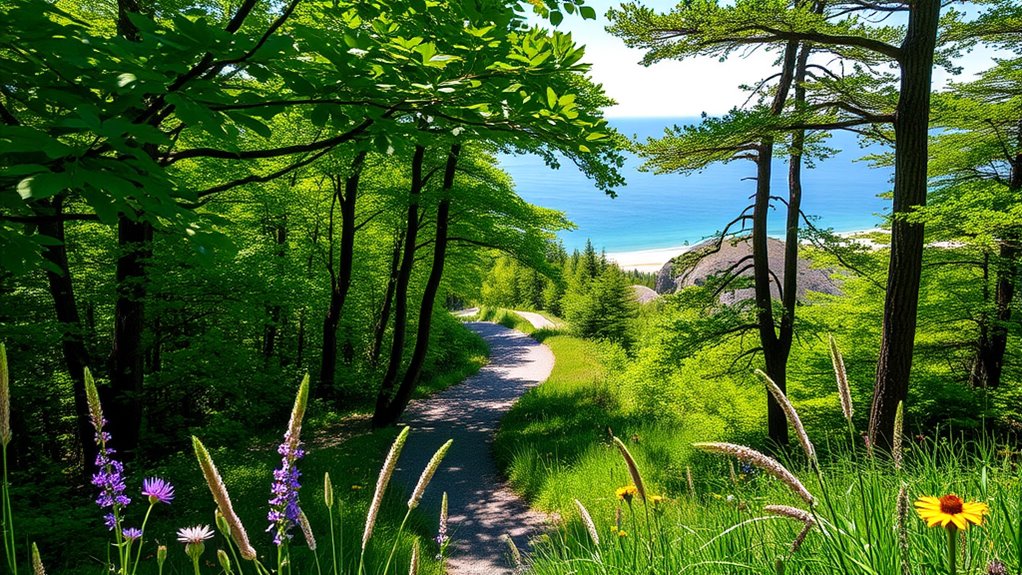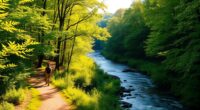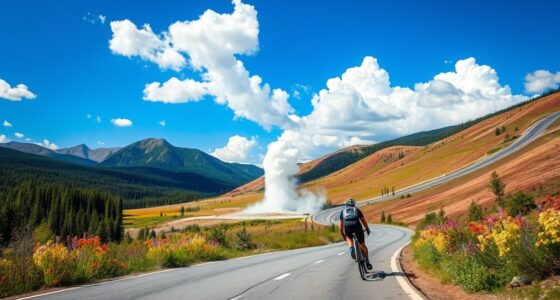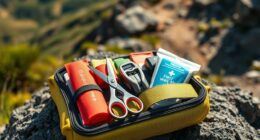Pedal through Washington’s Olympic Discovery Trail, where stunning forests transition into breathtaking coastlines! This 135-mile trail is perfect for cycling, offering diverse terrains from lush rainforests to scenic ocean views. You’ll explore unique ecosystems, including old-growth forests and alpine meadows. Whether you’re a leisurely rider or seeking a challenge, there’s something for everyone. Plus, don’t miss the exciting events along the way. Stick around to discover more about this incredible trail and what it has to offer!
Key Takeaways
- The Olympic Discovery Trail spans over 135 miles, offering cyclists a scenic journey from lush forests to stunning coastal views.
- The trail features diverse terrains, including old-growth forests, mountains, and coastlines, perfect for biking enthusiasts.
- Cyclists can explore sections like the West, which descends into rainforests before reaching the Pacific Ocean.
- Along the route, riders can enjoy breathtaking vistas of the Olympic Mountains and the Salish Sea.
- Annual events, such as the NW Cup Downhill MTB Race, provide exciting opportunities for biking on the trail.
Overview of the Olympic Discovery Trail
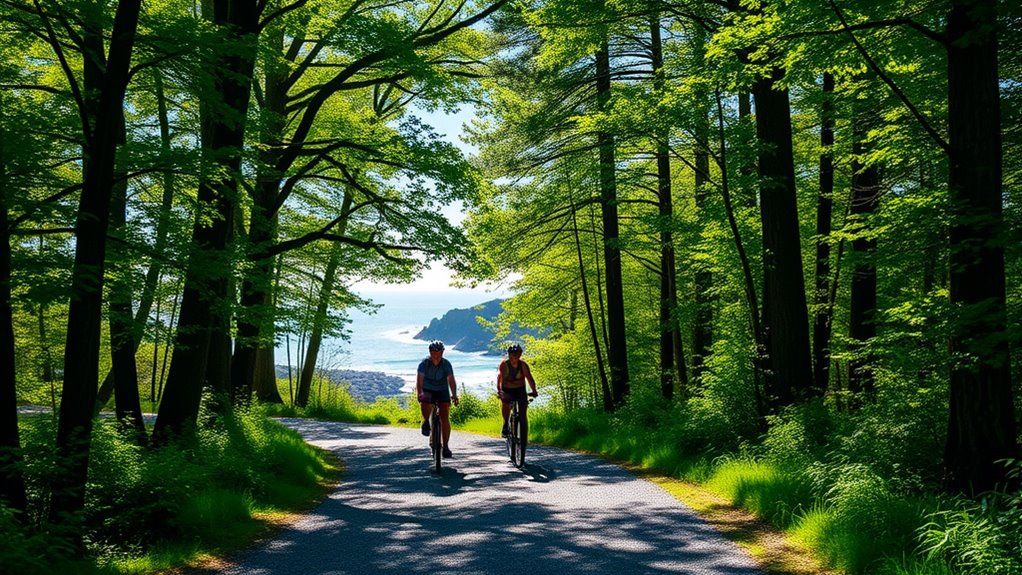
The Olympic Discovery Trail stretches over 135 miles along the northern edge of Washington’s Olympic Peninsula, with about 92 miles currently completed.
This diverse trail combines rail trails, rural corridors, side roads, and highway shoulders, making it accessible for walking, running, cycling, and horseback riding.
As you explore, you’ll encounter stunning landscapes, from forests and rivers to breathtaking coastlines and mountains.
The trail is divided into three main sections: the East around Port Townsend and Sequim, the Central section featuring Port Angeles and the Dungeness River, and the West near the Elwha River and Lake Crescent.
Plus, the Adventure Trail offers a 25-mile off-road alternative for mountain bikers and hikers craving a challenge.
History and Development of the Trail

As you delve into the history and development of the Olympic Discovery Trail, you’ll discover its roots in the former Seattle and North Coast Railroad corridor. Abandoned in the mid-1980s, this corridor was repurposed thanks to the vision of three cyclists who founded the Peninsula Trails Coalition (PTC).
Early on, they faced resistance from property owners and developers, but collaboration with various agencies proved essential. Development began in the late 1980s, with significant funding, including a $16 million grant, fueling progress.
Over 35 years, thousands of volunteers dedicated their time to create about 92 miles of completed trail. Key projects like the Dungeness River Bridge reconstruction and the Elwha River dam removal illustrate the trail’s commitment to community and environmental sustainability.
Exploring the Trail Sections
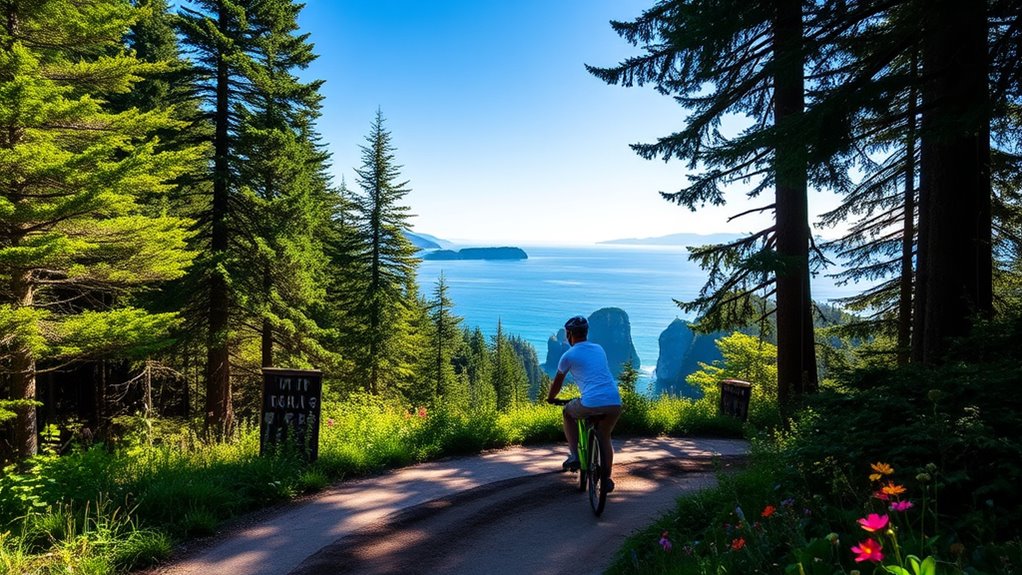
Whether you’re seeking a leisurely stroll or an adventurous bike ride, exploring the Olympic Discovery Trail‘s various sections offers something for everyone.
This 135-mile trail, with 92 miles completed, winds through Clallam and Jefferson counties, connecting Port Townsend to La Push.
Start your journey in the East Section from Port Townsend, featuring forests and farmland, or venture into the East Central Section, which spans historic railroad trestles.
The West Central Section offers stunning views of the Elwha River and Lake Crescent, while the West Section descends into lush rainforests before reaching the Pacific Ocean.
With diverse terrains and access points, you can choose your perfect outdoor experience, whether you walk, bike, or ride.
Scenic Highlights and Ecosystems
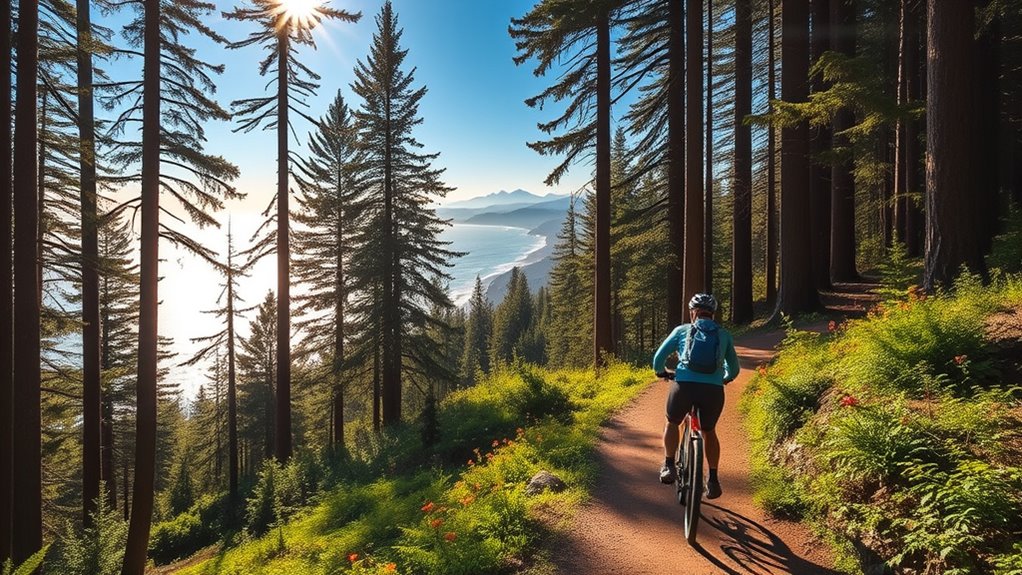
While traversing the Olympic Discovery Trail, you’ll encounter a rich tapestry of scenic landscapes and diverse ecosystems that showcase the region’s natural beauty.
You’ll be treated to stunning coastal views of the Strait of Juan de Fuca and the expansive Salish Sea, while breathtaking vistas of the glacier-topped Olympic Mountains surround you.
As you ride along the north shore of Lake Crescent, the deep, glacier-carved waters glisten invitingly. The trail winds through lush old-growth forests and temperate rainforests, offering glimpses of diverse wildlife, including deer and golden eagles.
Alpine meadows and tidal estuaries enrich the experience, highlighting the ecological significance of this remarkable area. Each turn reveals a new aspect of nature’s splendor, beckoning you to explore further.
Activities and Events Along the Trail
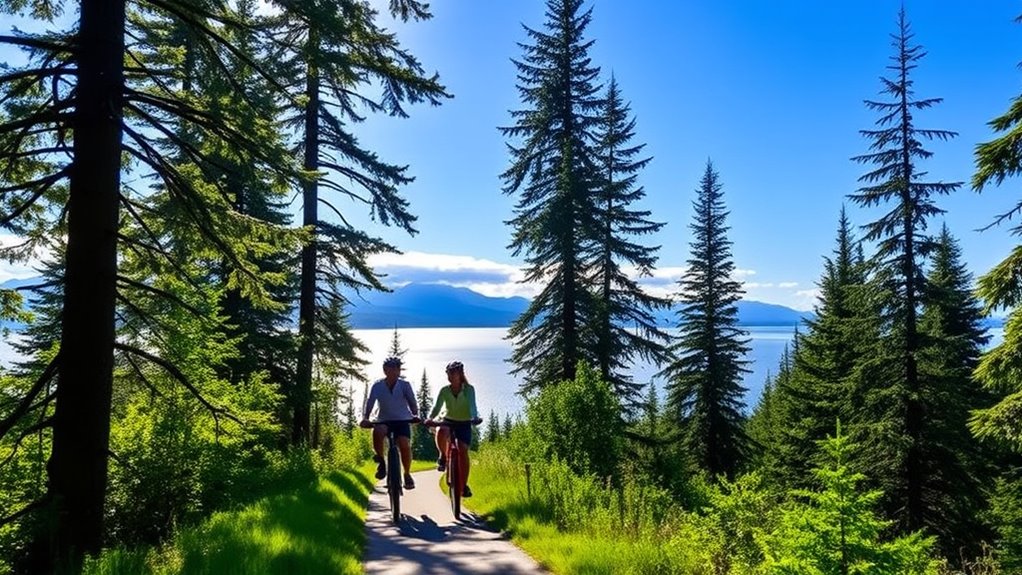
The Olympic Discovery Trail offers a wealth of activities and events that cater to outdoor enthusiasts of all kinds. You can enjoy walking, hiking, and trail running, with scenic views and varied terrain awaiting you.
If cycling’s more your speed, there are leisurely rides as well as challenging routes like the Olympic Adventure Trail. Horseback riding and inline skating are also popular options, making it easy to explore the area in different ways.
Fishing along rivers adds to the trail’s charm. Participate in exciting events, such as relay races, marathons, and guided bike tours that delve into local history.
Don’t miss annual events like the NW Cup Downhill MTB Race and the challenging Ride the Hurricane. There’s something for everyone!
Infrastructure and Accessibility Features
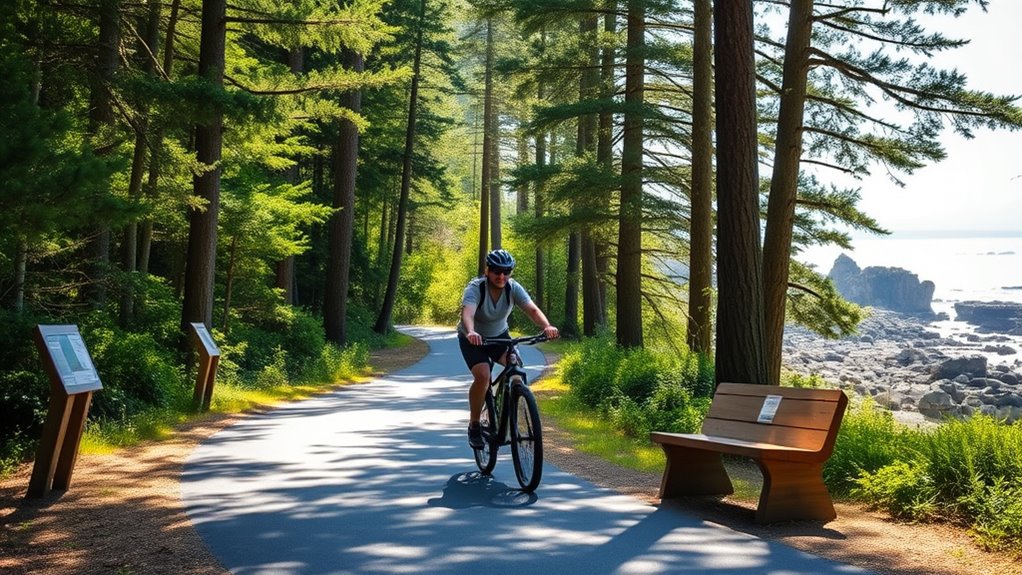
As you explore the Olympic Discovery Trail, you’ll appreciate its well-developed infrastructure and accessibility features that enhance your outdoor experience.
Spanning approximately 130-135 miles, about 75% of the trail is complete, offering a mix of wide paved sections, narrow dirt paths, and historic railroad tunnels like the McFee and Daley Rankin.
The Elwha River Bridge provides a safe pedestrian-only crossing. Notably, the Spruce Railroad Trail segment is ADA-compliant, ensuring wheelchair accessibility with wide, paved surfaces.
Improved parking facilities at locations like the Lyre River Trailhead accommodate oversized vehicles.
With rockfall mitigation measures in place, the trail is designed for diverse users, including hikers, cyclists, and equestrians, making it a welcoming destination for everyone. Additionally, the trail’s diverse terrain allows for enhanced visual experiences through the surrounding natural beauty, similar to the way high-quality projectors improve image quality in home cinema settings.
Getting Involved: Community Engagement and Volunteer Opportunities
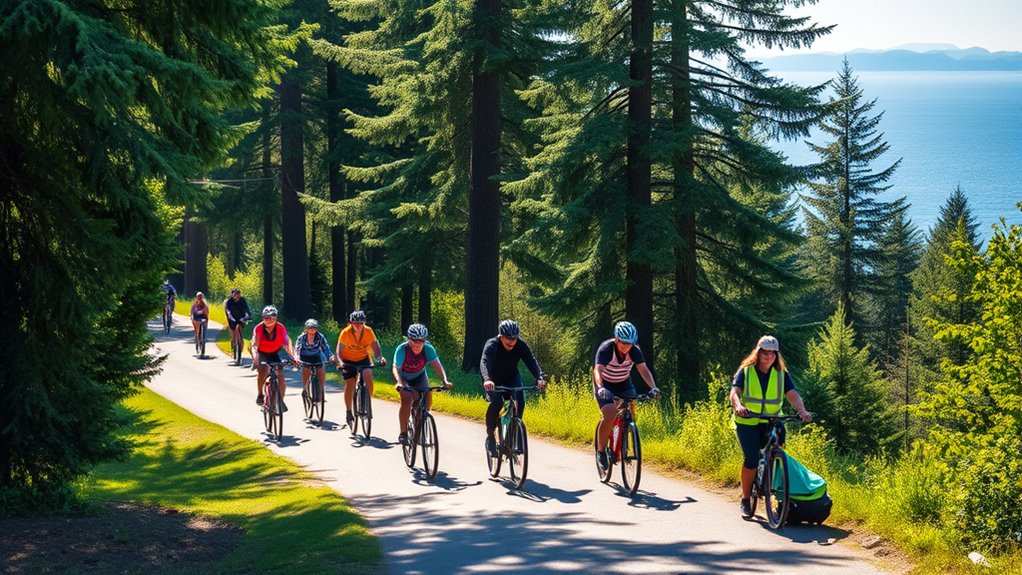
Getting involved in the Olympic Discovery Trail not only enhances your outdoor experience but also strengthens community ties.
You can contribute by volunteering for trail maintenance, ensuring it remains safe and accessible for everyone. Join events like the Tour de Lavender, where your support helps raise funds for trail development.
If you’re interested in hands-on work, assist in building new sections, such as the route from Forks to La Push. Engage in community outreach to promote the trail’s benefits and participate in fundraising activities to secure resources for ongoing projects.
Frequently Asked Questions
What Is the Best Time of Year to Visit the Trail?
The best time to visit the trail is during late summer and early fall.
You’ll enjoy mild temperatures and fewer crowds, making your experience more enjoyable.
Summer offers dry conditions and longer days, perfect for outdoor activities.
However, if you prefer a quieter atmosphere, fall’s vibrant leaves and cooler weather can be appealing.
Just remember, spring can be unpredictable, and winter may pose accessibility challenges, so plan accordingly!
Are There Any Fees to Access the Olympic Discovery Trail?
You won’t encounter any specific access fees for the Olympic Discovery Trail itself.
Many of the trailheads, like Fairholme, are free to use.
However, keep in mind that nearby attractions, such as Olympic National Park, do have entrance fees.
You won’t need special permits for casual trail use, but it’s good to check if you plan on exploring national park activities that might require them.
Enjoy your adventure!
Can I Bring My Dog on the Trail?
“Every dog has its day,” and your furry friend can enjoy the Olympic Discovery Trail with you!
While the trail itself doesn’t have specific pet restrictions, nearby areas do.
Keep in mind that if you venture into Olympic National Park, dogs are only allowed in certain areas, while Olympic National Forest welcomes them on all trails.
Just remember to leash your pet when required, and always clean up after them!
Is Camping Allowed Along the Trail?
Yes, camping is allowed along the trail.
You can choose between dispersed camping on National Forest land, which is free for up to two weeks, or developed campgrounds offering amenities like showers and picnic tables.
Be sure to check local regulations, as some areas require permits or reservations.
If you’re looking for a unique experience, consider specialized camping options like The Cycle Camp or alpaca farm sites.
Just remember to pack appropriately!
Where Can I Find Trail Maps and Guides?
You’ll find plenty of resources for trail maps and guides.
Did you know the trail spans 135 miles? Start with TrailLink.com for detailed maps and planning tools.
The ODT official website has updates on trail conditions, while local bike shops and visitor centers offer printed maps and insider tips.
Don’t forget to check mobile apps for downloadable maps, ensuring you’re prepared for your adventure on the trail!
Conclusion
In conclusion, the Olympic Discovery Trail offers a journey as vibrant and varied as the Pacific Northwest itself. Whether you’re pedaling through lush forests or feeling the ocean breeze along the coast, each section reveals something new and exciting. Embrace the chance to connect with nature, meet fellow adventurers, and make unforgettable memories. So grab your bike, hit the trail, and let the spirit of exploration guide you on this captivating adventure!
